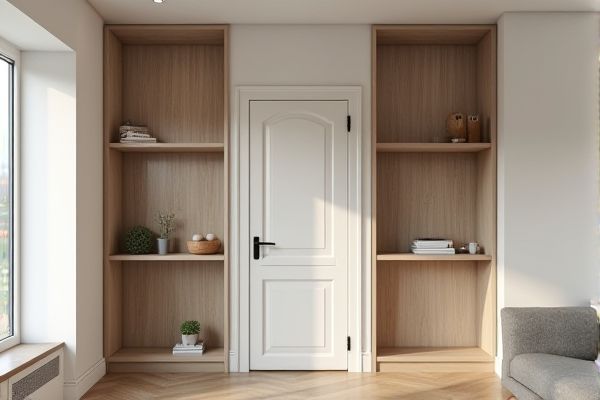
Door-mounted storage maximizes unused space by utilizing the back of cabinet doors for organizing small items, while shelf storage offers more capacity for larger or bulkier items within cabinets or closets. Explore the rest of the article to discover which option best fits your storage needs and home organization goals.
Table of Comparison
| Feature | Door-Mounted Storage | Shelf Storage |
|---|---|---|
| Space Utilization | Maximizes unused door space | Uses visible, often larger space |
| Accessibility | Easy access when door is open | Quick access, always visible |
| Capacity | Limited by door size | Higher capacity, adjustable |
| Installation | Requires mounting hardware | Often built-in or freestanding |
| Stability | Less stable, subject to door movement | Stable, supports heavier items |
| Ideal Use | Small items, spices, cleaning supplies | Larger items, books, kitchenware |
| Cost | Generally lower cost | Varies, often higher depending on size |
Introduction to Door-Mounted and Shelf Storage
Door-mounted storage maximizes space by utilizing the inside of cabinet doors, offering easy access to smaller items and reducing countertop clutter. Shelf storage provides versatile organization by accommodating larger items and maintaining visibility, ideal for pantry essentials or kitchenware. Choosing between door-mounted and shelf storage depends on the available space, item size, and accessibility needs.
Key Differences Between Door-Mounted and Shelf Storage
Door-mounted storage maximizes vertical space by attaching compartments directly to cabinet doors, making small areas like kitchens or bathrooms more efficient. Shelf storage provides open or closed flat surfaces ideal for versatile item organization and bulkier objects but requires more room. Your choice depends on accessibility needs and the type of items you frequently store.
Space Efficiency: Maximizing Small Areas
Door-mounted storage offers superior space efficiency by utilizing often-overlooked vertical space on doors, making it ideal for small areas where floor and shelf space is limited. Shelf storage, while providing easy access and visibility, occupies fixed horizontal space and may require additional clearance for larger items, reducing usable room in compact environments. Maximizing small spaces is best achieved through door-mounted solutions that free up shelves and counters for bulkier items, enhancing overall organization without expanding the storage footprint.
Installation Requirements and Ease
Door-mounted storage requires minimal installation tools, often involving adhesive hooks or brackets that avoid wall damage, making it ideal for renters or quick setups. Shelf storage demands sturdier installation, typically requiring drilling into walls or studs for secure mounting, which can be time-consuming and less flexible in placement. Ease of installation favors door-mounted options for convenience, while shelves offer more stability but need careful planning and hardware.
Accessibility and Convenience
Door-mounted storage offers superior accessibility by utilizing vertical space, keeping frequently used items within arm's reach and reducing the need to bend or stretch. Shelf storage, while providing larger capacity, often requires deeper reaching and can cause items to become less visible or harder to retrieve. Choosing door-mounted options enhances convenience in tight spaces and supports quicker organization of essentials.
Storage Capacity Comparison
Door-mounted storage typically offers limited storage capacity due to its slim design, suitable for smaller items like spices or cleaning supplies. Shelf storage provides significantly greater capacity, accommodating larger and bulkier items such as cookware, pantry goods, and appliances. Maximizing vertical space, shelf storage is ideal for comprehensive organization and heavier storage needs within kitchens or closets.
Aesthetic and Design Considerations
Door-mounted storage offers a sleek, space-saving solution that keeps items hidden, maintaining a clean and minimalist look ideal for modern interiors. Shelf storage provides open visibility, allowing for decorative displays that enhance room aesthetics but may create visual clutter if not organized carefully. Choosing between the two depends on the desired balance between streamlined design and showcasing personal style through accessible items.
Versatility for Different Items and Rooms
Door-mounted storage maximizes vertical space by offering adjustable compartments ideal for small items like spices, cleaning supplies, or toiletries, making it versatile for kitchens, bathrooms, and closets. Shelf storage provides broader, open areas suitable for larger or bulkier items such as books, cookware, or folded linens, fitting well in living rooms, garages, or pantries. Both types enhance organization but cater to different spatial needs and item sizes, optimizing storage efficiency in various rooms.
Cost Analysis: Door-Mounted vs Shelf Storage
Door-mounted storage typically offers a more cost-effective solution compared to traditional shelf storage due to lower material and installation expenses. Shelf storage often requires additional support structures and larger space allocations, leading to higher overall costs. You can maximize budget efficiency by choosing door-mounted options that utilize existing door surfaces without compromising accessibility.
Choosing the Right Storage Solution for Your Needs
Door-mounted storage maximizes space efficiency by utilizing often-overlooked vertical areas, ideal for small rooms or kitchens with limited floor space. Shelf storage offers greater versatility and accessibility, perfect for organizing larger items or frequently used belongings. Assess Your available space and storage requirements to determine whether the compact convenience of door-mounted units or the expansive capacity of shelves best suits Your needs.
 homyna.com
homyna.com